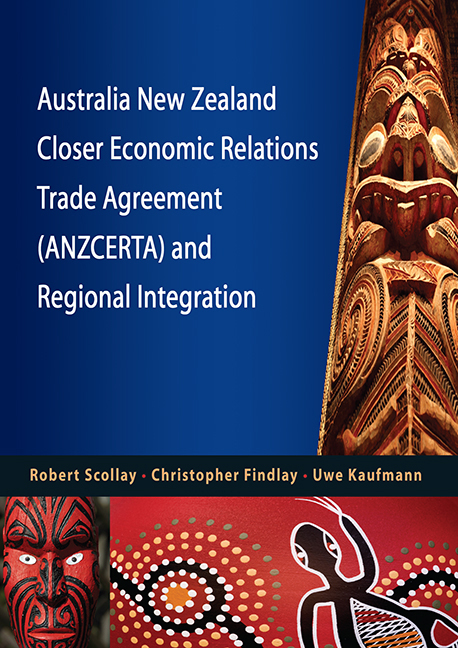Book contents
- Frontmatter
- Contents
- Foreword
- Australia New Zealand Closer Economic Relations Trade Agreement (Anzcerta) and Regional Integration
- Executive Summary
- 1 Introduction
- 2 Background
- 3 Pre-ANZCERTA Trade Arrangements
- 4 Early Years of ANZCERTA
- 5 Consolidation of ANZCERTA
- 6 Deepening Integration
- 7 Pursuit of a Single Economic Market (SEM)
- 8 Further Monetary Integration: A Monetary Union?
- 9 The Economic Effects of ANZCERTA
- 10 Conclusion
- References
- About the Authors
6 - Deepening Integration
from Australia New Zealand Closer Economic Relations Trade Agreement (Anzcerta) and Regional Integration
Published online by Cambridge University Press: 21 October 2015
- Frontmatter
- Contents
- Foreword
- Australia New Zealand Closer Economic Relations Trade Agreement (Anzcerta) and Regional Integration
- Executive Summary
- 1 Introduction
- 2 Background
- 3 Pre-ANZCERTA Trade Arrangements
- 4 Early Years of ANZCERTA
- 5 Consolidation of ANZCERTA
- 6 Deepening Integration
- 7 Pursuit of a Single Economic Market (SEM)
- 8 Further Monetary Integration: A Monetary Union?
- 9 The Economic Effects of ANZCERTA
- 10 Conclusion
- References
- About the Authors
Summary
The period since the early 1990s has seen the further formalization and deepening of economic integration between the two countries across the broad range of issues covered in the integration framework that had been established at the end of the preceding decade. Much of this progress involved programmes and processes developed to give effect to the commitments to further cooperation arising from understandings reached in the 1988 review and its immediate aftermath. In other cases the governments responded to newly emerging problems or to pressure from the business communities in one or both countries.
The level of priority given by the two governments to trans-Tasman economic integration tended to vary over time. Lloyd (1995) notes that some variation in the prioritization of issues was related to domestic politics in each country. He also notes that pressure for further deepening of integration tended to emanate more from the New Zealand side, whereas the Australian Government was more inclined to be content with the level of integration already achieved. He relates this to the obvious fact that the relationship is of much greater relative importance to New Zealand than to Australia, so that New Zealand would generally tend to see greater gains from further integration. Against this background the maintenance of momentum owed much to the intensive programme of regular meetings established between various groups of officials and ministers to give effect to the understandings reached between the two governments, as well as the formal reviews of ANZCERTA which took place, for example, in 1992 and 1995.
Trade in Goods: Rules of Origin
Difficulties with the ANZCERTA rules of origin, especially on the New Zealand side, were a frequent subject for discussion. As a result the rules were modified in ways designed to provide some additional flexibility, but the 50 per cent RVC requirement remained the basis of the rules. Inability to reach agreement on a substantial lowering of the RVC requirement was said to be a contributing factor to the closure of the New Zealand motor vehicle assembly industry in 1998 (Scollay et al. 1998).
- Type
- Chapter
- Information
- Australia New Zealand Closer Economic Relations Trade Agreement (ANZCERTA) and Regional Integration , pp. 34 - 57Publisher: ISEAS–Yusof Ishak InstitutePrint publication year: 2010



